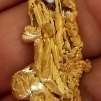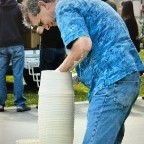Leaderboard
Popular Content
Showing content with the highest reputation on 05/22/2016 in all areas
-
Got up this morning and bumped into my Orig. Tesoro Lobo (20 kHz). I had nothing to do this morning so I went out to the local city park and did some detecting in the tot lot with the Lobo. Didn't find anything exciting but had fun with this Classic!!!!! I quickly remembered how great the discrimination is on this detector, one of the best that I have used. No ID #'s but it didn't matter. Set the discrimination on 4 and proceeded to hunt. Beep and dig! Spent a couple of hours just messing around and realized what a great detector the Original Lobo is and how cool it was to be using a 15 year old detector that worked just as good as when it was new. Thank You Tesoro for a great morning and a product you should be very proud of manufacturing!!!!! Jimmy4 points
-
does a small backhoe come with one of these coils? Seriously, I just dug a 3 foot hole and found a shovel, and thats with my gpx and 15x9 coil. I don't see it as a practical coil for the Sierras .... but open , non trashy patches.....hell yeah !!!!2 points
-
2 points
-
Well sit back because today you will get the rest of the story. Now mark this down being it all happen this week. On Tuesday Tom at White's Tells me he will ship my MX Sport out that day with UPS using 2 day air. What can I say but thank you. I get a e mail from UPS saying they have 2 boxes for me and I'll get it Thursday. I didn't early say anything about the other box that White's was going to send me that had the 9.5 concentric coil in it.I wanted them to just exchange it for 10 DD but Tom said no we'll just give it to you. Being as humble as I am I said thank you again. I waited all day for my detector to come and at 7:45 in the evening it was here. No No No I was wrong I just had one box but not the one with mt MX Sport. You may think that Superman is fast but he is nothing on leaving your house as a UPS Guy is. UPS was gone and even my wife look at the box asking is your detector in that small box.. Right away I get a number for UPS. Well I call them and believe this are not but they tell me White's put a stop on the box say # 1. They didn't know why other than White's wanted it back. .That Thursday I PM Tom and told him what UPS said and I gave his my cell number too. The next morning little after 10 Texas time I get a call from Tom. He too couldn't believe it. This time he was eating humble pie telling me how sorry he was. I told him he didn't do it but I'd like to know who and why. We talk again on Friday and he said it would take too long to get my detector back and reship it. He told me that he would over night a new MX Sport to me. Well it was my time to eat humble pie and again I said thank you. Here it is 10 AM Saturday and my door bell rings. I walk out and of all things the UPS guy was still sitting there but by my door was brand new MX Sport metal detector. Don't never say it's not a God are White's Electronics and above all I want to remember how TOM made it all happen. In the other box was the concentric coil a black bag to carry it all in. I also had the 6 x 10 coil and a MX Sport cap. I ask Tom about the 6 x 10 being I have one already and said I can do with what I want. Well I'll tell you right now it will go back and the extra headphones too. I got the extra shaft with this detector but I think I've been humble enough.Haha Your right it's not going back. I took out two sports that was me and my MX Sport detecting. I wanted to go to this school ground but a ball game was going on. I hunted a short time at another school in front and the first thing I got a hit on was a quarter the next was a penny. The MX Sport ran smooth and you need to be ready to dig deeper than ever before. I need more time detecting but just on the little I seen today I can't help but like it.. This has been a trip but thanks to people like Tom who works at White's all is well at Chuck's house. Chuck . .2 points
-
1 point
-
Geeeeez, it just occurred to me, that titanium partial-knee replacement I'm now walking/kneeling on would become a definite no-no for considering this coil. AND you'd probably have to take to dragging your pick on a long rope behind you too, no more hiding it behind your body. (Actually, that might be a cool practice for finding those stray meteorites in some areas.) I'll sit this one out till you all test it out. Besides, if I wait a year+, they'll lower the ?? price 30%, much like they did with my 'mother-ship' ZED. ?☹️1 point
-
The indepent saved settings for each mode, and better yet the ability to switch quickly between modes is very useful. The Gold Racer is set up the same way. I run one disc mode with optimum hunt settings. The second I run a very high settings, too high for general sweeping. I hunt with one, then switch to the other to boost the signal response on a found target. It is also easy to hunt in all metal, then switch to disc mode to check found targets. It is one of the best features of these machines and I wish more detectors allowed quick mode switching.1 point
-
Paul, Hey that guide arm is very important! You better slide it on, mine has been there since day one...don't know what I'd do without it...lol Rick1 point
-
My clip mysteriously missing when tromping through the heavy brush. A relic for someone when they invent the plastic detector.1 point
-
I know nothing!...just stirring the pot up a bit...one of my favorite things to do! fred1 point
-
One detector not mentioned yet that I would get in the water with is the Garret AT's.1 point
-
Oh yes John that is the first thing I done and it went to 8. I'll report more as time goes by and test the other coils. Chuck1 point
-
Looks like we are going to have to interrogate Fred a wee bit, maybe even torture him with irradiation from a 19" coil, with evidence coming to light looks like he`s holding out. Suspect his downunder contacts are coming good, plus KLs being a wee silent lately, plot thickens. What ya say Sherlock?1 point
-
Chris and I at least have had nothing to do with the development of the 19" coil and have been waiting for it just like everyone else.1 point
-
Scuttlebutt in AU was they would be closer to 2000.00-- I'll take 2 please!!!! lololol.. And i will have to sign a contract with someone i know for earthmoving equipment !!!1 point
-
Yeah that makes me dirty, but the young fellas need a head start. That`s why us old fellas are at the bottom of the pre-order list, don`t matter how many order after us we are still on the bottom, Crikey I`m definitely dirty. Time we advanced KL some seed capital, to build the ultimate detector, trouble is I suspect his R&D program would be really R&R. But I`m sure he`d look after us old fellas and give us a leg in, well maybe he will. You sure you haven`t inside info Fred..............$@%&$%#@1 point
-
I'm also going to wait, I'm not buying until I see a 30% increase in the fun I'm going to have...so far the jury selection hasen't even started yet, have to see how the new open coil and everything shakes first.1 point
-
Scott, I'm with ya sitting in the sideline...maybe ML will send me one to give it a go...lol. You can talk all day about a bigger coil going deeper for a large nugget, but ML doesn't talk about if it has the same sensitivity to the bread and butter nuggets we are finding with the GPZ stock coil. Most see it for myself in the goldfields...seeing is believing for 1500 bones! Rick1 point
-
Unless I hear of superb reports from real life users,astronomical depth increases. I think I'll just sit and wait on this for awhile. I haven't been searching in too many wide open spaces ,been finding my gold in the harder to reach nooks and crannies. So I'd prefer a smaller elipictal.1 point
-
When I got into metal detecting in 1972 it was pretty simple. No discrimination, everything went beep, just dig it all up and see what you find. Advances came rapidly however, and manufacturers focused on making detectors that could eliminate trash to the highest degree possible while find coins. Coin detecting was the big market by far, as silver coins were still relatively common in parks and other locations. So the goal was to find a silver coin while ignoring everything else. Anything smaller than a dime was generally considered a trash target, so sensitivity to small items was actually not a good thing. Low frequency detectors that handled the ground well and ignored tiny trash items ruled the day. Most detectors ran around 6 - 8 khz. Then we got multi frequency, the first and most popular being the Fisher CZ detectors running at 5 khz and 15 khz. The desire there is not what most people think. Single frequency machines do not handle a combination of conductive and magnetic properties well at the same time, the classic place being a salt water beach with a little black sand in the beach sand. Two frequencies can be used to compare signals and reduce both the salt signal and the magnetic signal simultaneously more efficiently than single frequency machines. Multi frequency machines, in particular the Minelab BBS and FBS models, excel at accurate target identification. Again, sensitivity to tiny objects has not been the goal but instead accurate discrimination and ground elimination. The culmination came with notch discrimination and the ability to pick and choose specific target ranges to accept or reject. Always, when designing the detectors, when it came to borderline targets, the engineers focused on the idea that people hate digging trash. There is an ability on borderline targets to bias the detector response. You can find more good items if you let the machine do so but in return there will be more false positives and more trash dug. or you can really try and suppress trash signals, but some good targets get rejected with them. What I am talking about is the classic "iffy" targets. Ones that are extra deep, or next to a trash item, on edge, or which for various other reasons give mixed or broken signals. The machines got real efficient at cherry picking out the easy targets, and those started to disappear. All the online discussions and books started to focus on the need to dig those iffy targets to get results in places considered "hunted out". A detector running in all metal mode reports everything going on under the coil. Detectors running in discrimination modes do not but instead eliminate signals based on various criteria. The detector "sees" what it thinks is a trash target, and instead of a signal could be set to give no signal at all. The trash items just become invisible. A problem exists when a good item is directly under or next to a trash item that has been rejected. The detector, if set to ignore the trash item, also ignores the good item directly under the trash item. This is called target masking. But it gets a lot worse than that. The detector must ignore the trash target, then the circuit must reset, and then report the next item that comes along under the coil. This actually takes time, and that time frame is called the recovery time or recovery speed. The simple test for this is to put a nail next to a dime, and sweep the coil first over the nail and then the dime. If the dime is too close to the nail, it gets ignored along with the nail. If the detector has a very slow recovery speed, the nail and the dime can be inches apart and the dime is still eliminated! The faster the recovery time, the closer the dime can be to the nail and still have the dime signal. Many things can be learned doing this. First, sweep speed matters. Going slower gives the detector time to reset so if you sweep too fast, you miss the dime. Go slower, it can sound off. Second, direction matters. Dime next to nail, if coil is swept 90 degree across the nail, the dime gets missed. Turn and sweep along the length of the nail, and now the dime appears. This is why classic coin detecting skills recommends hunting a location from multiple directions. Coil size and type matters tremendously. Big coils have more chance of both the nail and dime being under the coil at once, and both being ignored. Small coils have a better chance of separating the targets. DD coils do better yet by narrowing the detection pattern. Tuning matters. If you set the detector to aggressively ignore all nails it is more likely to ignore the dime. If you set the discrimination to just barely reject the nail, even so far as letting it produce a pip or broken response, and now the dime may very well sound off also. In general you should only set to reject medium to small ferrous trash. Tuning out bolts will really mask about everything. Then people realized setting the nail to be silent and the coin to beep caused more masking than using two tones. A low tone for nails, and a high tone for dimes. Totally suppressing the nail is more likely to kill the signal from the dime. Letting tones flow from low to high keeps the audio circuit open and more likely to report the nail. All these tricks get combined, and so running with multiple tones, small coils, going slow, etc. all add up to more good finds being made. Now, certain machines have always excelled at this, in particular the Tesoro detectors and some older White's models. These were/are detectors with analog style single knob discrimination controls that could set a very fine point on where the discrimination point was between ferrous and non-ferrous. But as the new digital machines came online, we actually lost some of this capability because digital signals get broken down into small pieces for processing. Think old LP record versus early digital file recordings of music like MP3. An analog signal is continuous whereas a digital signal is a zillion little bits glued end to end, and just fast enough to sound continuous. It is like the frame rate on a movie file. It looks continuous to our eye but is actually distinct separate frames strung together. This digital type audio has been described as "gated audio", like a gate opening and closing, letting signals through. Analog type signals are described as "blended audio" or "bleedy signals" because the audio flows, blends, and bleeds together. With digital style audio the detector looks at a signal, decides if it is good or bad, assigns a tone (or no sound), then opens the gate and lets you hear it. Then it stops and looks at the next chunk, decides again, and opens the gate again before slamming it shut. Still with me? This is the biggie. It is this gated audio response and recovery times determined by processor speed that combine to mask targets. It gets worse. A dime right under a nail can be masked. The fun part is the deeper the dime is under the nail, the larger the area of masking is that occurs. If I sit where I am right now and hold my thumb up in front of my coffee cup, I can see the cup with my thumb in front of it. Now if I pull my thumb towards my eye and away from the cup, I can completely hide my coffee cup from view behind my thumb. Detectors actually have a similar "field of vision" effect going on, and recent surface trash can block out a lot or nearly all coins buried deeper down. Get the picture? You have a park where the surface inch or two is full of trash dropped the last thirty years. Under that are all those old silver coins you are looking for. But you have your detector set to reject all that surface trash and the coins get eliminated right along with it. There is far more silver lurking to be found than people realize. Still, all the way up to now, Fisher, Garrett, Minelab, and White's in particular have been cranking out detectors with the old "I do not want to dig trash" mindset at work, and the machines all have suffered from relatively slow recovery times and a bias against calling borderline targets good but instead calling them bad. And as a rule that has worked well enough for the U.S. market, especially because there were no alternatives and more importantly, people really had no idea what they were missing. VLF nugget detectors early on dealt with this, and the Gold Bug 2 and GMT both have ferrous id systems. However, their extreme sensitivity to tiny items and edge sensitivity to certain ferrous trash items like flat steel sections of rotted and disintegrated cans makes them impractical for most detecting outside of serious nugget hunting or perhaps micro jewelry detecting. Newer nugget machines like the Gold Bug Pro with a small coil up to now have been about as good as it gets for pulling non-ferrous targets out of ferrous trash and they are pretty darn good at it. That is why Gold Bug Pro variants like the Teknetics G2 and now the F19 and G2+ have been popular with and marketed to coin and relic hunters. The Garrett AT Gold is more popular with coin and relic hunters than nugget hunters for the same reasons. However, a detector renaissance of sorts has been taking place in Europe. They have thousands of years of ferrous trash in the ground and non-ferrous targets of all sorts scattered around in it. The very first thing that became obvious to them was that U.S. style discrimination schemes were pretty useless. The target types are too varied, so job one in Europe is to just dig all non-ferrous targets. The vast amount of trash in the ground also means recovery time is a large factor. The fields are huge and the hours long so light weight detectors are also favored. When I went to the UK for my hunt years ago I took a Fisher F75. At the time is was about the fastest swinging, fast recovery rate hot on small non-ferrous targets machine you could get in the U.S. The F75 and Tek T2 made a lot of their reputation in their ability to pull non-ferrous items out of ferrous trash. The reality is however that they still had some recovery time issues and a definite bias on borderline targets that cause non-ferrous items to be mis-identified as ferrous. The Europeans wanted something better. Some companies though simply ignored the market or figured what they had was good enough. Minelab in particular comes to mind. Where is their light weight, fast swinging, fast recovery detector? The X-Terra 705? Sorry, no. Tesoro has some good detectors but people really do want to see new detectors now and then, and they are content to just crank out twenty year old models. An opening was created, a vacuum that companies we never heard of decided to fill. Now, it just so happens all of this, everything I have described above, applies to looking for gold nuggets in trashy camp and other mining locations littered with ferrous targets. I have always kept an eye on what goes on in the relic hunting and European worlds because the needs and desires almost perfectly overlap with what nugget hunters need in trashy locations. And so a funny thing happened. Machines that work very well for nugget detecting started to appear in Europe. Names like the XP DEUS and Vista Gold entered my radar zone. One company, Nokta, suddenly appeared and targeted U.S. nugget hunters directly along with their sister company Makro. XP decided to get in on the game and added a Gold program to the DEUS. Most of this was actually driven more by the Africa market more than the U.S. market, as these days Africa is where the big bucks have been in nugget detector sales. The difference is that the DEUS in particular vastly improved the recovery time and it is now regarded as perhaps the best machine made for pulling non-ferrous targets out of ferrous trash. They did it using gated audio but with very fast and sophisticated audio processing. Nokta and Makro are doing something a bit different because their machines rely more on a circuit that almost perfectly duplicates the blended audio responses of old style analog machines but combined with digital discrimination. They also have the ability to sport much smaller coils than currently exist for the DEUS and so Nokta/Makro also have made inroads. Similar results can be obtained with either but with vastly different stylistic differences. The DEUS is the epitome of high tech wizardry, the Nokta/Makro units so far much more basic machines. DEUS is what White's could have done had they not been asleep at the wheel. All the pieces existed long ago with the XLT. And when I look at the Nokta/Makro detectors I see what could have been with Tesoro if they had not just stopped making new detectors. It is what it is however, and Euro style detectors are making waves and inroads into the U.S. markets, but almost as an afterthought as these companies target Europe and Africa. This long post all came about because I was out comparing a truck load of detectors again in the field, and the simple basic fact once again was right there before my very eyes. It all kind of boils down to two very broad classes of machines aimed at two very different end users. End user type one is common in the United States. The park or turf hunter. Park hunting requires sensitivity to outside factors, number one being that you just can't go crazy and dig holes everywhere. People like machines with high levels of accurate discrimination that deliver few false positives. In other words machines that focus on not digging a hole just to recover a trash item. The Minelab BBS and FBS machines like the Explorers and CTX 3030 are famous in this regard. They really are not the deepest detecting machines around by a long shot, but what they deliver is accurate discrimination results to depths beyond what most if any other machines deliver. I have a White's V3i that never really sees any use outside of parks because I like its incredible visual and audio discrimination customization features. The Euro machines do get criticism because while they are extremely good at telling ferrous from non-ferrous, they by design do allow for more false positives. A deep borderline coin in bad ground that my F75 will identify as ferrous a Euro machine will call good and have me dig it. What they really do not tell you is that the Euro machines do not tend to separate out different categories of non-ferrous targets very well, and so you find yourself digging all sorts of things like pull tabs because they end up sounding like a coin. And even a nail now and then. What I am trying to say with all this is that Euro style machines are really, really great for relic hunters and nugget hunters, or anyone who simply wants to recover all possible non-ferrous targets out of the middle of ferrous trash, or are willing to dig all non-ferrous targets in parks and other locations. What they really are not so great at is cherry picking certain types and categories of targets, and in general you will just dig more trash with the Euro machines than what I am calling the U.S. style machines even though that includes Minelab, an Australian company. Now you will get people who say they can cherry pick with a DEUS or FORS CoRe, and people who will say they can pull goodies out of thick ferrous trash with their Minelab Explorer, and of course that is true. I just think you are fighting the true underlying nature of the machines. This article is for the newer people out there who are confused by it all and looking for a little honest guidance. My advice boils down to this. If you simply want to dig all non-ferrous targets, machines made by Nokta, Makro, Tesoro, and XP excel at this task. If you really hate digging any trash at all and want to focus on certain targets only, like U.S. coins, then machines made by First Texas, Garrett, Minelab, and White's tend to focus more on what I would call "turf hunting" or hunting parks, schoolyards, etc where a high degree of discrimination is paramount to reduce needless digging. There are of course other companies but I have to keep things limited to the larger and more visible ones because things are already too complicated as it is. No matter which detector you use however, even the best cannot change the basic facts of target masking. There is stuff out there hidden under trash targets, and the only way to find those items is to remove the trash item first. The trashier the site, the more likely there are good items hidden away waiting to be found. There is no such thing as recovery time or target masking in all metal mode. In places where high value items are very likely to exist, nothing can be done but to dig it all if you want to be sure and not miss that once in a lifetime find. Beneath The Mask by Thomas Dankowski1 point










.thumb.jpg.77e4cb5bf39d44bdd2050d2edb7dfdb1.jpg)

